Effect of Architectural Building Design Parameters on Thermal Comfort and Energy Consumption in Higher Education Buildings
Abstract
1. Introduction
2. Research Methods
2.1. Simulation Process Using Monte Carlo (MC) Technique
2.2. Prototype Description of the Application of BES Model to Building Design Example and Climate
- −32.80 latitude and 151.83 longitude.
- Altitude of 33 m above sea level.
- Mean annual minimum and maximum temperatures of 14.3 °C and 21.8 °C.
- Annual mean global radiation of 4.8 kWh/m2.
2.3. Determination of Input and Output Variables
2.4. Sampling and Assignment of Probability Density Functions
| # | Input Parameter (Probability Distribution: Normal) | Input Units | Summary Statistics | ||||||
|---|---|---|---|---|---|---|---|---|---|
| Min | Max | Mean | Median | Q1 * (25%) | Q3 * (75%) | SD * | |||
| 1 | Window to wall ratio [11,16,51,56] | % | 5 | 75 | 40 | 40 | 33 | 47 | 10 |
| 2 | Cooling set-point temperature [16,51] | °C | 19 | 28 | 25 | 25 | 24 | 26 | 2 |
| 3 | Heating set-point temperature [16,51] | °C | 17 | 23 | 20 | 20 | 19 | 21 | 1 |
| 4 | Building orientation [11,56] | Angle (°θ ) | 0 (N) * | 315 | 157 | 135 | 45 | 225 | 103 |
| 5 | Occupancy density [86] | people/m2 | 0.1 | 0.5 | 0.3 | 0.3 | 0.3 | 0.3 | 0.05 |
| 6 | Mech. Vent. rate per area [87] | l/s/m2 | 2 | 8 | 5 | 5 | 4 | 6 | 1 |
| 7 | Thermal mass [16,51] | - | −1 | 1 | −0.001 | 0 | −1 | 1 | 0.8 |
| 8 | Roof window opens ratio [88,89] | % | 3 | 17 | 10 | 10 | 9 | 11 | 2 |
| 9 | Infiltration [16,86] | Ac/h | 0.4 | 2 | 1 | 1 | 0.9 | 1 | 0.2 |
| # | Input Parameter (Probability Distribution: Discrete) | Input Details | |
|---|---|---|---|
| 10 | External wall construction [11,16,56,88,91] | Description | Frequency |
| U-value = 1.949 * | 371 | |
| R-value = 0.513 * | |||
| U-value = 0.950 | 370 | |
| R-value = 1.053 | |||
| U-value = 0.403 | 367 | |
| R-value = 2.482 | |||
| U-value = 0.351 | 372 | |
| R-value = 2.846 | |||
| U-value = 2.767 | 366 | |
| R-value = 0.361 | |||
| 11 | Roof construction [11,56,88,91] | ||
| U-value = 3.439 | 311 | |
| R-value = 0.291 | |||
| U-value = 2.605 | 301 | |
| R-value = 0.384 | |||
| U-value = 1.431 | 308 | |
| R-value = 0.699 | |||
| U-value = 6.223 | 308 | |
| R-value = 0.161 | |||
| U-value = 0.252 | 310 | |
| R-value = 3.972 | |||
| U-value = 0.239 | 308 | |
| R-value = 4.192 | |||
| 12 | Glazing type [11,16,56,88] | ||
| U-value = 6.257 | 362 | |
| SHGC = 0.713 | |||
| U-value = 5.302 | 378 | |
| SHGC = 0.320 | |||
| U-value = 2.708 | 365 | |
| SHGC = 0.697 | |||
| U-value = 3.226 | 373 | |
| SHGC = 0.619 | |||
| U-value = 1.798 | 368 | |
| SHGC = 0.643 | |||
| 13 | Local shading type [11,86] | 0.5 m projection Louvre | 230 |
| 1.0 m projection Louvre | 235 | ||
| 1.5 m projection Louvre | 234 | ||
| No shading | 222 | ||
| 0.5 m Overhang | 235 | ||
| 1.0 m Overhang | 231 | ||
| 1.5 m Overhang | 231 | ||
| 2.0 m Overhang | 228 | ||
| 14 | Location template [94,95] | Newcastle | 923 |
| Sydney | 923 | ||
| 15 | Crack template (airtightness) [96,97,98] | Excellent | 364 |
| Good | 373 | ||
| Medium | 373 | ||
| Poor | 366 | ||
| Very poor | 372 | ||
3. Results and Discussion
3.1. Uncertainty Analysis (UA)
3.2. Sensitivity Analysis (SA)
3.2.1. Influential Factors on Energy Consumption for Each Output
3.2.2. Influential Factors on Thermal Comfort for each Output
3.3. The Effect of ABDPs on Indoor Thermal Environment
3.3.1. Effect of Cooling and Heating Set-Point Temperatures
3.3.2. Effect of Roof and Wall Construction and Thermal Mass
3.3.3. Effect of Glazing, Window to Wall Ratio and Shading Devices
3.3.4. Effect of Occupancy Density
3.3.5. Effect of Infiltration Rate and Mechanical Ventilation Rate per Area
3.3.6. Effect of Building Orientation
3.4. Relationship between Students’ Thermal Discomfort Hours and Building Energy Consumption
4. Conclusions
- (1)
- The simulation results showed a significant potential to optimise the ABDPs to achieve energy saving and thermal comfort in educational buildings in NSW, Australia.
- (2)
- Based on the parametric and sensitivity analyses, there is a very weak relationship between the students’ thermal discomfort hours and the building cooling/heating load. However, the cooling and heating set-point temperatures, as well as roof construction, had a significant impact on the sensitivity of the ABDPs for both building energy consumption and student thermal comfort (p = 0.0000).
- (3)
- Increasing the cooling set-point temperature from 22 °C to 28 °C and using a U-value of 0.239 W/m2K in roof construction can reduce the operative temperatures by 14.2% and 20.0%, respectively. These reductions could significantly lower the thermal discomfort hours by 6.0 and 3.25 times, respectively.
- (4)
- The findings of this study are particularly useful for architectural design teams because they enable designers to decide easily which of the sensitive ABDPs are more important than the others based on the simulation outcomes. Moreover, architectural design teams can save time by not focusing on ABDPs that have small effects on thermal comfort and energy consumption.
- (5)
- However, there remains a number of important challenges and areas for additional study. For example, there is a need for more studies regarding indoor thermal performance and students’ thermal comfort, as well as students’ academic performance. More work is required to design performance criteria to quantitatively evaluate the ABDPs with UA and SA capabilities.
Author Contributions
Funding
Institutional Review Board Statement
Informed Consent Statement
Data Availability Statement
Acknowledgments
Conflicts of Interest
Acronyms
| ABCB | Australian Building Codes Board |
| ABDPs | Architectural Building Design Parameters |
| BCA | Building Code of Australia |
| BES | Building Energy Simulation |
| EPW | EnergyPlus Weather file |
| HVAC | Heating, Ventilation and Air Conditioning |
| IAQ | Indoor Air Quality |
| IEQ | Indoor Environmental Quality |
| LHS | Latin Hypercube Sampling |
| MC | Monte Carlo |
| MV | Mechanical Ventilation |
| NSW | New South Wales |
| PA | Parametric Analysis |
| PMV | Predicted Mean Vote |
| PPD | Predicted Percentage Dissatisfaction |
| ROC | Rate Of Change |
| SA | Sensitivity Analyses |
| SD | Standard Deviation |
| SHGC | Solar Heat Gain Coefficient |
| SRC | Standardised Regression Coefficient |
| UA | Uncertainty Analysis |
References
- Pérez-Lombard, L.; Ortiz, J.; Coronel, J.F.; Maestre, I.R. A review of HVAC systems requirements in building energy regulations. Energy Build. 2011, 43, 255–268. [Google Scholar] [CrossRef]
- UN Environment. Global Status Report. 2017. Available online: https://www.worldgbc.org/sites/default/files/UNEP%20188_GABC_en%20%28web%29.pdf (accessed on 10 February 2019).
- Ascione, F.; Bianco, N.; Böttcher, O.; Kaltenbrunner, R.; Vanoli, G.P. Net zero-energy buildings in Germany: Design, model calibration and lessons learned from a case-study in Berlin. Energy Build. 2016, 133, 688–710. [Google Scholar] [CrossRef]
- Li, J.; Yu, Z.J.; Haghighat, F.; Zhang, G. Development and improvement of occupant behavior models towards realistic building performance simulation: A review. Sustain. Cities Soc. 2019, 50, 101685. [Google Scholar] [CrossRef]
- Al-Homoud, M.S. A Systematic Approach for the Thermal Design Optimization of Building Envelopes. J. Build. Phys. 2005, 29, 95–119. [Google Scholar] [CrossRef]
- Calì, D.; Osterhage, T.; Streblow, R.; Müller, D. Energy performance gap in refurbished German dwellings: Lesson learned from a field test. Energy Build. 2016, 127, 1146–1158. [Google Scholar] [CrossRef]
- De Wit, M.S. Uncertainty in Predictions of Thermal Comfort in Buildings; Institutional Repository: Delft, The Netherlands, 2002. [Google Scholar]
- Rabani, M.; Madessa, H.B.; Nord, N. Achieving zero-energy building performance with thermal and visual comfort enhancement through optimization of fenestration, envelope, shading device, and energy supply system. Sustain. Energy Technol. Assess. 2021, 44, 101020. [Google Scholar] [CrossRef]
- Energy, U.D.O. An assessment of energy technologies and research opportunities. In Quadrennial Technology Review; United States Department of Energy: Washington, DC, USA, 2015. [Google Scholar]
- Šujanová, P.; Rychtáriková, M.; Mayor, T.S.; Hyder, A. A Healthy, Energy-Efficient and Comfortable Indoor Environment, a Review. Energies 2019, 12, 1414. [Google Scholar] [CrossRef]
- Mirrahimi, S.; Mohamed, M.F.; Haw, L.C.; Ibrahim, N.L.N.; Yusoff, W.F.M.; Aflaki, A. The effect of building envelope on the thermal comfort and energy saving for high-rise buildings in hot–humid climate. Renew. Sustain. Energy Rev. 2016, 53, 1508–1519. [Google Scholar] [CrossRef]
- Attia, S.; Hamdy, M.; O’Brien, W.; Carlucci, S. Assessing gaps and needs for integrating building performance optimization tools in net zero energy buildings design. Energy Build. 2013, 60, 110–124. [Google Scholar] [CrossRef]
- Manioğlu, G.; Yılmaz, Z. Energy efficient design strategies in the hot dry area of Turkey. Build. Environ. 2008, 43, 1301–1309. [Google Scholar] [CrossRef]
- Rafiq, M.Y.; Mathews, J.D.; Bullock, G.N. Conceptual Building Design—Evolutionary Approach. J. Comput. Civ. Eng. 2003, 17, 150–158. [Google Scholar] [CrossRef][Green Version]
- Al-Tamimi, N.; Fadzil, S.F.S.; Harun, W.M.W. The Effects of Orientation, Ventilation, and Varied WWR on the Thermal Performance of Residential Rooms in the Tropics. J. Sustain. Dev. 2011, 4, 142–149. [Google Scholar] [CrossRef]
- Yıldız, Y.; Arsan, Z.D. Identification of the building parameters that influence heating and cooling energy loads for apartment buildings in hot-humid climates. Energy 2011, 36, 4287–4296. [Google Scholar] [CrossRef]
- Cellura, M.; Guarino, F.; Longo, S.; Mistretta, M. Energy life-cycle approach in Net zero energy buildings balance: Operation and embodied energy of an Italian case study. Energy Build. 2014, 72, 371–381. [Google Scholar] [CrossRef]
- Tabor, J.; Chatterjee, K.; Ghosh, T.K. Smart Textile-Based Personal Thermal Comfort Systems: Current Status and Potential Solutions. Adv. Mater. Technol. 2020, 5, 1901155. [Google Scholar] [CrossRef]
- Kosanović, S.; Fikfak, A.; Folić, B. Sustainability and resilience—(In)consistencies in two design realms. In Sustainable and Resilient Building Design: Approaches, Methods and Tools; TU Delft Open: Delft, The Netherlands, 2018; pp. 67–82. [Google Scholar]
- Mishra, A.; Derks, M.; Kooi, L.; Loomans, M.; Kort, H. Analysing thermal comfort perception of students through the class hour, during heating season, in a university classroom. Build. Environ. 2017, 125, 464–474. [Google Scholar] [CrossRef]
- Allab, Y.; Pellegrino, M.; Guo, X.; Nefzaoui, E.; Kindinis, A. Energy and comfort assessment in educational building: Case study in a French university campus. Energy Build. 2017, 143, 202–219. [Google Scholar] [CrossRef]
- Singh, M.; Ooka, R.; Rijal, H. Thermal comfort in Classrooms: A critical review. In Proceedings of the 10th Windsor Conference—Rethinking Comfort, Windsor, UK, 12–15 April 2018. [Google Scholar]
- Humphreys, M.A.; Nicol, J.F.; Raja, I.A. Field Studies of Indoor Thermal Comfort and the Progress of the Adaptive Approach. Adv. Build. Energy Res. 2007, 1, 55–88. [Google Scholar] [CrossRef]
- Kwok, A.G.; Chun, C. Thermal comfort in Japanese schools. Sol. Energy 2003, 74, 245–252. [Google Scholar] [CrossRef]
- Indraganti, M.; Rao, K.D. Effect of age, gender, economic group and tenure on thermal comfort: A field study in residential buildings in hot and dry climate with seasonal variations. Energy Build. 2010, 42, 273–281. [Google Scholar] [CrossRef]
- Karjalainen, S. Thermal comfort and gender: A literature review. Indoor Air 2011, 22, 96–109. [Google Scholar] [CrossRef] [PubMed]
- Pereira, L.D.; Raimondo, D.; Corgnati, S.P.; da Silva, M.C.G. Assessment of indoor air quality and thermal comfort in Portuguese secondary classrooms: Methodology and results. Build. Environ. 2014, 81, 69–80. [Google Scholar] [CrossRef]
- Baranova, D.; Sovetnikov, D.; Semashkina, D.; Borodinecs, A. Correlation of energy efficiency and thermal comfort depending on the ventilation strategy. Procedia Eng. 2017, 205, 503–510. [Google Scholar] [CrossRef]
- Zhang, G.; Zheng, C.; Yang, W.; Zhang, Q.; Moschandreas, D.J. Thermal Comfort Investigation of Naturally Ventilated Classrooms in a Subtropical Region. Indoor Built Environ. 2007, 16, 148–158. [Google Scholar] [CrossRef]
- Baker, N.; Standeven, M. Thermal comfort for free-running buildings. Energy Build. 1996, 23, 175–182. [Google Scholar] [CrossRef]
- Goto, T.; Toftum, J.; de Dear, R.; Fanger, P.O. Thermal sensation and thermophysiological responses to metabolic step-changes. Int. J. Biometeorol. 2006, 50, 323–332. [Google Scholar] [CrossRef]
- Tushar, W.; Wang, T.; Lan, L.; Xu, Y.; Withanage, C.; Yuen, C.; Wood, K.L. Policy design for controlling set-point temperature of ACs in shared spaces of buildings. Energy Build. 2017, 134, 105–114. [Google Scholar] [CrossRef]
- Wang, Y.; Kuckelkorn, J.M.; Zhao, F.-Y.; Liu, D.; Kirschbaum, A.; Zhang, J.-L. Evaluation on classroom thermal comfort and energy performance of passive school building by optimizing HVAC control systems. Build. Environ. 2015, 89, 86–106. [Google Scholar] [CrossRef]
- Bojic, M.; Patou Parvedy, A.; Boyer, H. Optimization of thermal comfort in building through envelope design. arXiv 2013, arXiv:1302.5941. [Google Scholar]
- Hoque, S.; Weil, B. The relationship between comfort perceptions and academic performance in university classroom buildings. J. Green Build. 2016, 11, 108–117. [Google Scholar] [CrossRef]
- Figueiredo, A.; Figueira, J.; Vicente, R.; Maio, R. Thermal comfort and energy performance: Sensitivity analysis to apply the Passive House concept to the Portuguese climate. Build. Environ. 2016, 103, 276–288. [Google Scholar] [CrossRef]
- Fantozzi, F.; Hamdi, H.; Rocca, M.; Vegnuti, S. Use of Automated Control Systems and Advanced Energy Simulations in the Design of Climate Responsive Educational Building for Mediterranean Area. Sustainability 2019, 11, 1660. [Google Scholar] [CrossRef]
- El Khattabi, E.M.; Mharzi, M.; Raefat, S.; Meghari, Z. On the Application of a New Thermal Diagnostic Model: The Passive Elements Equivalent in Term of Ventilation Inside a Room; IOP Publishing: Bristol, UK, 2018; Volume 353, p. 012003. [Google Scholar]
- Ashtiani, A.; Mirzaei, P.A.; Haghighat, F. Indoor thermal condition in urban heat island: Comparison of the artificial neural network and regression methods prediction. Energy Build. 2014, 76, 597–604. [Google Scholar] [CrossRef]
- Green Building Council of Australia. The future of Australian education–Sustainable places for learning. Aust. J. Environ. Educ. 2013, 29, 18–32. [Google Scholar]
- Department of Education, N.G. The Educational Facilities Standards & Guidelines (EFSG). Available online: https://efsg.det.nsw.edu.au/ (accessed on 4 July 2020).
- Council of Australian Governments [COAG]. Baseline Energy Consumption and Greenhouse Gas. In Emissions in Commercial Buildings in Australia; Department of Climate Change and Energy Efficiency: Dublin, Ireland, 2012. [Google Scholar]
- Ghita, S.A.; Catalina, T. Energy efficiency versus indoor environmental quality in different Romanian countryside schools. Energy Build. 2015, 92, 140–154. [Google Scholar] [CrossRef]
- Zaki, S.A.; Damiati, S.A.; Rijal, H.B.; Hagishima, A.; Razak, A.A. Adaptive thermal comfort in university classrooms in Malaysia and Japan. Build. Environ. 2017, 122, 294–306. [Google Scholar] [CrossRef]
- Velten, K. Mathematical modeling and simulation introduction for scientists and engineers. In Mathematical Modeling and Simulation for Scientists and Engineers; Wiley-VCH: Weinheim, Germany, 2009. [Google Scholar]
- Heiselberg, P.; Brohus, H.; Hesselholt, A.; Rasmussen, H.; Seinre, E.; Thomas, S. Application of sensitivity analysis in design of sustainable buildings. Renew. Energy 2009, 34, 2030–2036. [Google Scholar] [CrossRef]
- Moffiet, T.; Alterman, D.; Hands, S.; Colyvas, K.; Page, A.; Moghtaderi, B. A statistical study on the combined effects of wall thermal mass and thermal resistance on internal air temperatures. J. Build. Phys. 2015, 38, 419–443. [Google Scholar] [CrossRef]
- Buratti, C.; Moretti, E.; Belloni, E.; Cotana, F. Unsteady simulation of energy performance and thermal comfort in non-residential buildings. Build. Environ. 2013, 59, 482–491. [Google Scholar] [CrossRef]
- Stavrakakis, G.; Zervas, P.; Sarimveis, H.; Markatos, N. Development of a computational tool to quantify architectural-design effects on thermal comfort in naturally ventilated rural houses. Build. Environ. 2010, 45, 65–80. [Google Scholar] [CrossRef]
- Zhang, A.; Bokel, R.; Dobbelsteen, A.V.D.; Sun, Y.; Huang, Q.; Zhang, Q. The Effect of Geometry Parameters on Energy and Thermal Performance of School Buildings in Cold Climates of China. Sustainability 2017, 9, 1708. [Google Scholar] [CrossRef]
- Magnier, L.; Haghighat, F. Multiobjective optimization of building design using TRNSYS simulations, genetic algorithm, and Artificial Neural Network. Build. Environ. 2010, 45, 739–746. [Google Scholar] [CrossRef]
- Alghamdi, S.; Tang, P.; Kanjanabootra, S.; Alterman, D. Architectural Building Design Parameters in Australian Educational Buildings: A Review. Int. J. Adv. Mech. Civ. Eng. IJAMCE 2019, 2019, 65–72. [Google Scholar]
- Evins, R. A review of computational optimisation methods applied to sustainable building design. Renew. Sustain. Energy Rev. 2013, 22, 230–245. [Google Scholar] [CrossRef]
- Chong, A.; Xu, W.; Lam, K. Uncertainty Analysis In Building Energy Simulation. A Practical Approach. In Proceedings of the 4th International IBPSA Conference, Hyderabad, India, 7–9 December 2015. [Google Scholar]
- Pang, Z.; O’Neill, Z. Uncertainty quantification and sensitivity analysis of the domestic hot water usage in hotels. Appl. Energy 2018, 232, 424–442. [Google Scholar] [CrossRef]
- Yu, W.; Li, B.; Jia, H.; Zhang, M.; Wang, D. Application of multi-objective genetic algorithm to optimize energy efficiency and thermal comfort in building design. Energy Build. 2015, 88, 135–143. [Google Scholar] [CrossRef]
- Wilde, P.D. Building Performance Analysis; Wiley: New York, NY, USA, 2018. [Google Scholar]
- Garg, V. Building Energy Simulation: A Workbook Using DesignBuilder; Mathur, J., Tetali, S., Bhatia, A., Eds.; CRC Press: Boca Raton, FL, USA; Taylor & Francis Group: Boca Raton, FL, USA, 2017. [Google Scholar]
- Kaplan, M.; Caner, P. Guidelines for Energy Simulation of Commercial Buildings: Final; Kaplan Engineering: Portland, OR, USA, 1992. [Google Scholar]
- Leal, S. Case study of a simplified building energy modeling for performance simulation. Build. Simul. 2013, 2013, 333–339. [Google Scholar]
- Wang, S.; Xu, X. Simplified building model for transient thermal performance estimation using GA-based parameter identification. Int. J. Therm. Sci. 2006, 45, 419–432. [Google Scholar] [CrossRef]
- Macdonald, I.A. Quantifying the Effects of Uncertainty in Building Simulation; University of Strathclyde Glasgow: Glasgow, UK, 2002. [Google Scholar]
- Hopfe, C. The Impact of Future Climate Scenarios on Decision Making in Building Performance Simulation-A Case Study; University of Paris: Paris, France, 2009; p. 18. [Google Scholar]
- Breesch, H.; Janssens, A. Performance evaluation of passive cooling in office buildings based on uncertainty and sensitivity analysis. Sol. Energy 2010, 84, 1453–1467. [Google Scholar] [CrossRef]
- Loutzenhiser, P.; Manz, H.; Felsmann, C.; Strachan, P.; Frank, T.; Maxwell, G. Empirical validation of models to compute solar irradiance on inclined surfaces for building energy simulation. Sol. Energy 2007, 81, 254–267. [Google Scholar] [CrossRef]
- Barbhuiya, S.; Barbhuiya, S. Thermal comfort and energy consumption in a UK educational building. Build. Environ. 2013, 68, 1–11. [Google Scholar] [CrossRef]
- Issa, M.A.A. Building Performance Simulation for Architects, Comparing Three Leading Simulation Tools; The University of Texas: San Antonio, TX, USA, 2018. [Google Scholar]
- Solmaz, A.S. A critical review on building performance simulation tools. Alam Cipta 2019, 12, 7–21. [Google Scholar]
- Galbraith, S.; Daniel, J.; Vissel, B. A Study of Clustered Data and Approaches to Its Analysis. J. Neurosci. 2010, 30, 10601–10608. [Google Scholar] [CrossRef]
- Shiel, P.; Tarantino, S.; Fischer, M. Parametric analysis of design stage building energy performance simulation models. Energy Build. 2018, 172, 78–93. [Google Scholar] [CrossRef]
- Naboni, E. Comparison of Conventional, Parametric and Evolutionary Optimization Approaches for the Architectural Design of Nearly Zero Energy Buildings. In Proceedings of the 13th Conference of International Building Performance Simulation Association, Chambéry, France, 26–28 August 2013; pp. 26–28. [Google Scholar]
- Ulukavak Harputlugil, G.; Hensen, J.; Wilde, P. Simulation as a Tool to Develop Guidelines for the Design of School Schemes for Four Climatic Regions of Turkiye; Tsinghua University: Beijing, China, 2007. [Google Scholar]
- Chen, P.Y. Correlation parametric and nonparametric measures. In Quantitative Applications in the Social Sciences; Popovich, P.M., Ed.; SAGE: Thousands Oaks, CA, USA, 2002. [Google Scholar]
- Hennig, C. Handbook of Cluster Analysis, 1st ed.; Meila, M., Murtagh, F., Rocci, R., Eds.; CRC Press: Boca Raton, FL, USA, 2015. [Google Scholar]
- Bansal, A.; Sharma, M.; Goel, S. Improved K-mean Clustering Algorithm for Prediction Analysis using Classification Technique in Data Mining. Int. J. Comput. Appl. 2017, 157, 35–40. [Google Scholar] [CrossRef]
- Conry, M.C. The Clustering of Health Behaviours in Ireland and Their Relationship with Mental Health, Self-Rated Health and Quality of Life; BMC Public Health: Berlin, Germany, 2011; Volume 11, p. 692. [Google Scholar]
- Gravetter, F.J.; Forzano, L.A.B. Research Methods for the Behavioral Sciences; Cengage Learning: Boston, MA, USA, 2011. [Google Scholar]
- Aye, L.; Charters, W.W.S.; Fandino, A.M.; Robinson, J.R.W. Thermal performance of sustainable energy features. Solar 2005, 2005, 1–10. [Google Scholar]
- Balbis-Morejón, M.; Rey-Hernández, J.; Amaris-Castilla, C.; Velasco-Gómez, E.; José-Alonso, J.S.; Rey-Martínez, F. Experimental Study and Analysis of Thermal Comfort in a University Campus Building in Tropical Climate. Sustainability 2020, 12, 8886. [Google Scholar] [CrossRef]
- Pellegrino, M.; Simonetti, M.; Chiesa, G. Reducing thermal discomfort and energy consumption of Indian residential buildings: Model validation by in-field measurements and simulation of low-cost interventions. Energy Build. 2016, 113, 145–158. [Google Scholar] [CrossRef]
- Kisilewicz, T. On the Role of External Walls in the Reduction of Energy Demand and the Mitigation of Human Thermal Discomfort. Sustainability 2019, 11, 1061. [Google Scholar] [CrossRef]
- DesignBuilder Software. Comfort Analysis. Available online: https://designbuilder.co.uk//helpv2/Content/Comfort_Analysis.htm (accessed on 2 February 2021).
- Santamaria, B.M.; Gonzalo, F.A.; Aguirregabiria, B.; Ramos, J.H. Evaluation of Thermal Comfort and Energy Consumption of Water Flow Glazing as a Radiant Heating and Cooling System: A Case Study of an Office Space. Sustainability 2020, 12, 7596. [Google Scholar] [CrossRef]
- Caetano, D.S.; Kalz, D.E.; Lomardo, L.L.; Rosa, L.P. Evaluation of thermal comfort and occupant satisfaction in office buildings in hot and humid climate regions by means of field surveys. Energy Procedia 2017, 115, 183–194. [Google Scholar] [CrossRef]
- Manache, G.; Melching, C. Sensitivity of latin hypercube sampling to sample size and distributional assumptions. In Proceedings of the 32nd Congress of the International Association of Hydraulic Engineering and Research, Venice, Italy, 1–6 July 2007. [Google Scholar]
- Budaiwi, I.; Abdou, A. HVAC system operational strategies for reduced energy consumption in buildings with intermittent occupancy: The case of mosques. Energy Convers. Manag. 2013, 73, 37–50. [Google Scholar] [CrossRef]
- Daghigh, R. Assessing the thermal comfort and ventilation in Malaysia and the surrounding regions. Renew. Sustain. Energy Rev. 2015, 48, 681–691. [Google Scholar] [CrossRef]
- Wang, X.; Kendrick, C.; Ogden, R.; Walliman, N.; Baiche, B. A case study on energy consumption and overheating for a UK industrial building with rooflights. Appl. Energy 2013, 104, 337–344. [Google Scholar] [CrossRef]
- Lapisa, R.; Karudin, A.; Martias, M.; Krismadinata, K.; Ambiyar, A.; Romani, Z.; Salagnac, P. Effect of skylight–roof ratio on warehouse building energy balance and thermal–visual comfort in hot-humid climate area. Asian J. Civ. Eng. 2020, 21, 915–923. [Google Scholar] [CrossRef]
- Gray, J.B.; Cook, R.D.; Weisberg, S. Applied Regression Including Computing and Graphics. Technometrics 2000, 42, 426. [Google Scholar] [CrossRef]
- Mishra, P.; Pandey, C.M.; Singh, U.; Gupta, A.; Sahu, C.; Keshri, A. Descriptive statistics and normality tests for sta-tistical data. Ann. Card. Anaesth. 2019, 22, 67–72. [Google Scholar] [CrossRef]
- Vetter, T.R. Descriptive statistics: Reporting the answers to the 5 basic questions of who, what, why, when, where, and a sixth, so what? Anesth. Analg. 2017, 125, 1797–1802. [Google Scholar] [CrossRef]
- Kaliyadan, F.; Kulkarni, V. Types of Variables, Descriptive Statistics, and Sample Size. Indian Dermatol. Online J. 2019, 10, 82–86. [Google Scholar] [CrossRef]
- Hirashima, S.D.S.; Katzschner, A.; Ferreira, D.G.; De Assis, E.S.; Katzschner, L. Thermal comfort comparison and evaluation in different climates. Urban Clim. 2018, 23, 219–230. [Google Scholar] [CrossRef]
- Eskin, N.; Türkmen, H. Analysis of annual heating and cooling energy requirements for office buildings in different climates in Turkey. Energy Build. 2008, 40, 763–773. [Google Scholar] [CrossRef]
- Fernández-Agüera, J.; Domínguez-Amarillo, S.; Sendra, J.J.; Suárez, R. An approach to modelling envelope airtightness in multi-family social housing in Mediterranean Europe based on the situation in Spain. Energy Build. 2016, 128, 236–253. [Google Scholar] [CrossRef]
- Fernández-Agüera, J.; Domínguez-Amarillo, S.; Alonso, C.; Martín-Consuegra, F. Thermal comfort and indoor air quality in low-income housing in Spain: The influence of airtightness and occupant behaviour. Energy Build. 2019, 199, 102–114. [Google Scholar] [CrossRef]
- Rodrigues, L.; Tubelo, R.; Pasos, A.V.; Gonçalves, J.C.S.; Wood, C.; Gillott, M. Quantifying airtightness in Brazilian residential buildings with focus on its contribution to thermal comfort. Build. Res. Inf. 2020, 49, 639–660. [Google Scholar] [CrossRef]
- Boslaugh, S. Statistics in a Nutshell, 2nd ed.; O’Reilly: Beijing, China, 2012. [Google Scholar]
- Schmider, E.; Ziegler, M.; Danay, E.; Beyer, L.; Bühner, M. Is It Really Robust? Methodology 2010, 6, 147–151. [Google Scholar] [CrossRef]
- Hopfe, C.J.; Hensen, J.L.M. Uncertainty analysis in building performance simulation for design support. Energy Build. 2011, 43, 2798–2805. [Google Scholar] [CrossRef]
- Pianosi, F.; Beven, K.; Freer, J.; Hall, J.W.; Rougier, J.; Stephenson, D.B.; Wagener, T. Sensitivity analysis of environmental models: A systematic review with practical workflow. Environ. Model. Softw. 2016, 79, 214–232. [Google Scholar] [CrossRef]
- Gray, J. Applied Regression Analysis, Linear Models, and Related Methods; Sage Publications, Inc.: Thousands Oaks, CA, USA, 2012; Volume 40. [Google Scholar]
- Tan, J.; Cui, Y.; Luo, Y. Assessment of uncertainty and sensitivity analyses for ORYZA model under different ranges of parameter variation. Eur. J. Agron. 2017, 91, 54–62. [Google Scholar] [CrossRef]
- Gupta, S.K. The relevance of confidence interval and P-value in inferential statistics. Indian J. Pharmacol. 2012, 44, 143–144. [Google Scholar] [CrossRef]
- Chen, J. Advanced Technical Analysis Concepts-Rate of Change (ROC). Available online: https://www.investopedia.com/terms/r/rateofchange.asp (accessed on 20 May 2020).
- Kazanci, O.; Toftum, J.; Olesen, B.W. Effect of set-point variation on thermal comfort and energy use in a plus-energy dwelling. In Proceedings of the 9th Windsor Conference: Making Comfort Relevant, Windsor, UK, 7–10 April 2016. [Google Scholar]
- Hoyt, T.; Arens, E.; Zhang, H. Extending air temperature setpoints: Simulated energy savings and design considerations for new and retrofit buildings. Build. Environ. 2015, 88, 89–96. [Google Scholar] [CrossRef]
- Sadineni, S.B.; Madala, S.; Boehm, R.F. Passive building energy savings: A review of building envelope components. Renew. Sustain. Energy Rev. 2011, 15, 3617–3631. [Google Scholar] [CrossRef]
- Hashemi, A.; Cruickshank, H.; Cheshmehzangi, A. Improving thermal comfort in low-income tropical housing: The case of Uganda. In Proceedings of the ZEMCH 2015 International Conference, Bari & Lecce, Italy, 21–25 September 2015. [Google Scholar]
- Reilly, A.; Kinnane, O. The impact of thermal mass on building energy consumption. Appl. Energy 2017, 198, 108–121. [Google Scholar] [CrossRef]
- Balaras, C. The role of thermal mass on the cooling load of buildings. An overview of computational methods. Energy Build. 1996, 24, 1–10. [Google Scholar] [CrossRef]
- Bikas, D.; Chastas, P. The Effect of the U Value in the Energy Performance of Residential Buildings in Greece. J. Sustain. Arch. Civ. Eng. 2014, 6, 58–65. [Google Scholar] [CrossRef]
- Kumar, A.; Suman, B. Experimental evaluation of insulation materials for walls and roofs and their impact on indoor thermal comfort under composite climate. Build. Environ. 2013, 59, 635–643. [Google Scholar] [CrossRef]
- Christian, J.E.; Kosny, J. Thermal performance and wall ratings. ASHRAE J. 1996, 38, 3. [Google Scholar]
- Lyons, P.R.; Arasteh, D.; Huizenga, C. Window performance for human thermal comfort. Trans. Am. Soc. Heat. Refrig. Air Cond. Eng. 2000, 106, 594–604. [Google Scholar]
- Ralegaonkar, R.; Gupta, R. Review of intelligent building construction: A passive solar architecture approach. Renew. Sustain. Energy Rev. 2010, 14, 2238–2242. [Google Scholar] [CrossRef]
- Singh, M.; Garg, S. Energy rating of different glazings for Indian climates. Energy 2009, 34, 1986–1992. [Google Scholar] [CrossRef]
- Liping, W.; Hien, W.N. The impacts of ventilation strategies and facade on indoor thermal environment for naturally ventilated residential buildings in Singapore. Build. Environ. 2007, 42, 4006–4015. [Google Scholar] [CrossRef]
- Al-Tamimi, N.A.M. Impact of Building Envelope Modifications on the Thermal Performance of Glazed High-Rise Residential Buildings in the Tropics; University Science Malaysia: Penang, Malaysia, 2011. [Google Scholar]
- Pathirana, S.; Rodrigo, A.; Halwatura, R. Effect of building shape, orientation, window to wall ratios and zones on energy efficiency and thermal comfort of naturally ventilated houses in tropical climate. Int. J. Energy Environ. Eng. 2019, 10, 107–120. [Google Scholar] [CrossRef]
- Gugliermetti, F.; Bisegna, F. Daylighting with external shading devices: Design and simulation algorithms. Build. Environ. 2006, 41, 136–149. [Google Scholar] [CrossRef]
- Al-Tamimi, N.A.; Fadzil, S.F.S. The Potential of Shading Devices for Temperature Reduction in High.-Rise Residential Buildings in the Tropics. Proc. Eng. 2011, 21, 273–282. [Google Scholar] [CrossRef]
- Mjörnell, K.; Johansson, D.; Bagge, H. The Effect of High Occupancy Density on IAQ, Moisture Conditions and Energy Use in Apartments. Energies 2019, 12, 4454. [Google Scholar] [CrossRef]
- Elsharkawy, H.; Zahiri, S. The significance of occupancy profiles in determining post retrofit indoor thermal comfort, overheating risk and building energy performance. Build. Environ. 2020, 172, 106676. [Google Scholar] [CrossRef]
- Sfakianaki, A.; Pavlou, K.; Santamouris, M.; Livada, I.; Assimakopoulos, M.-N.; Mantas, P.; Christakopoulos, A. Air tightness measurements of residential houses in Athens, Greece. Build. Environ. 2008, 43, 398–405. [Google Scholar] [CrossRef]
- Faria, L.C.D.; Romero, M.D.A.; Porras-Amores, C.; Pirró, L.F.D.S.; Saez, P.V. Prediction of the Impact of Air Speed Produced by a Mechanical Fan and Operative Temperature on the Thermal Sensation. Buildings 2022, 12, 101. [Google Scholar] [CrossRef]
- Younes, C.; Shdid, C.A.; Bitsuamlak, G. Air infiltration through building envelopes: A review. J. Build. Phys. 2011, 35, 267–302. [Google Scholar] [CrossRef]
- Kent, R. Chapter 7-Buildings and Offices. In Energy Management in Plastics Processing, 3rd ed.; Kent, R., Ed.; Elsevier: Amsterdam, The Netherlands, 2018; pp. 345–370. [Google Scholar]
- Franco, A.; Schito, E. Definition of Optimal Ventilation Rates for Balancing Comfort and Energy Use in Indoor Spaces Using CO2 Concentration Data. Building 2020, 10, 135. [Google Scholar] [CrossRef]
- Maddalena, R.; Mendell, M.J.; Eliseeva, K.; Chan, W.; Sullivan, D.P.; Russell, M.; Satish, U.; Fisk, W.J. Effects of ventilation rate per person and per floor area on perceived air quality, sick building syndrome symptoms, and decision-making. Indoor Air 2015, 25, 362–370. [Google Scholar] [CrossRef] [PubMed]
- Allab, Y.; Kindinis, A.; Causone, F.; Tatti, A.; Simonet, S.; Bayeul-Lainé, A. Ventilation Rates and Thermal Comfort Assessment in a Naturally Ventilated Classroom; Aalborg University: Aalborg, Denmark, 2016. [Google Scholar]
- Wouters, P.; Barles, P.; Blomsterberg, Å.; Bulsing, P.; De Gids, W.; Delmotte, C.; Faÿsse, J.C.; Filleux, C.; Hardegger, P.; Leal, V.; et al. Towards Improved Performances of Mechanical Ventilation Systems. Tip-Vent Project, EC Joule. Research Funded by The European Commission in the framework of Non Nuclear Enery Programme, Joule IV. 2001. Available online: https://www.researchgate.net/publication/313573886_Towards_improved_performances_of_mechanical_ventilation_systems (accessed on 10 February 2019).
- Ahsanullah, S.I.; Van Zandt, S. The impact of zoning regulations on thermal comfort in non-conditioned housing in hot, humid climates: Findings from Dhaka, Bangladesh. Neth. J. Hous. Built Environ. 2014, 29, 677–697. [Google Scholar] [CrossRef]
- Albatayneh, A.; Alterman, D.; Page, A.; Moghtaderi, B. The Significance of the Orientation on the Overall buildings Thermal Performance-Case Study in Australia. Energy Procedia 2018, 152, 372–377. [Google Scholar] [CrossRef]
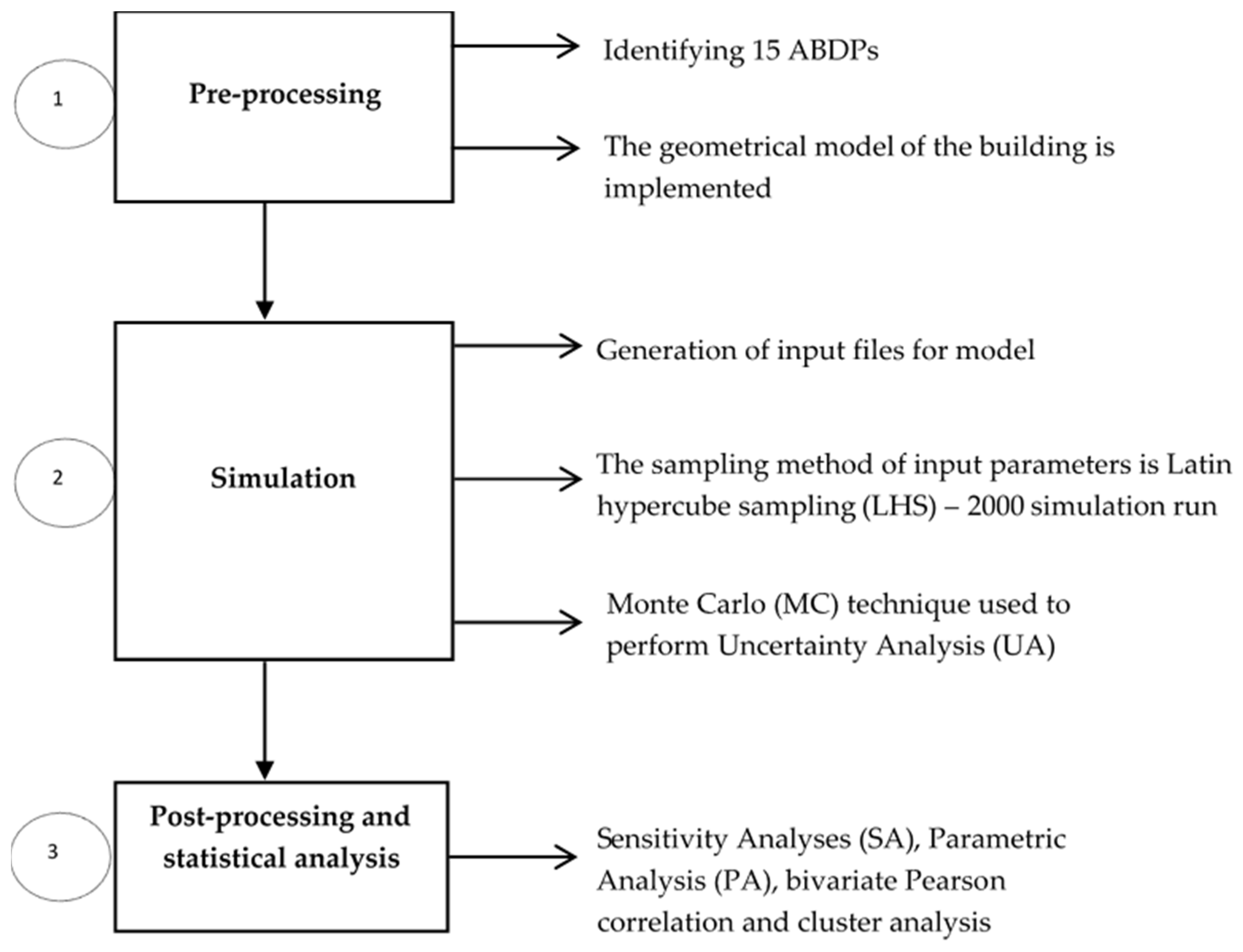
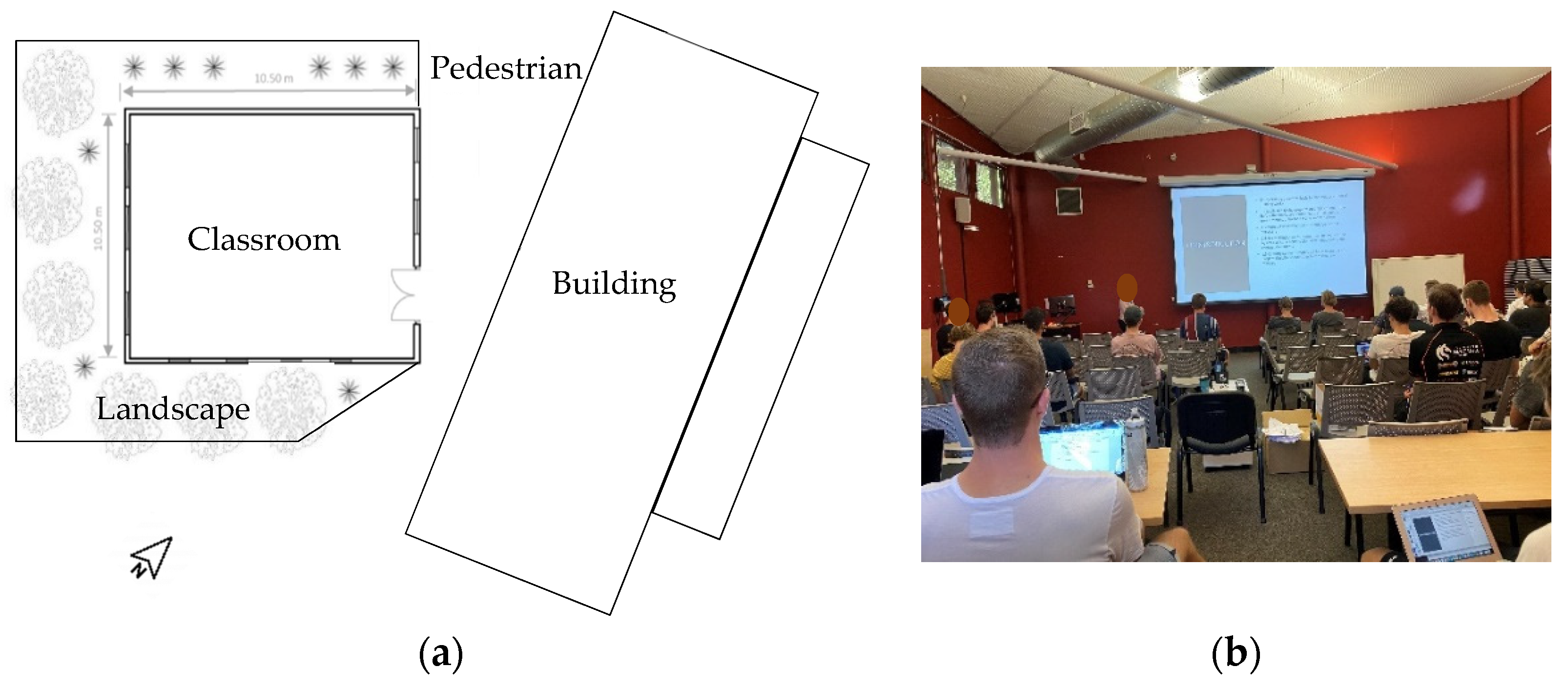

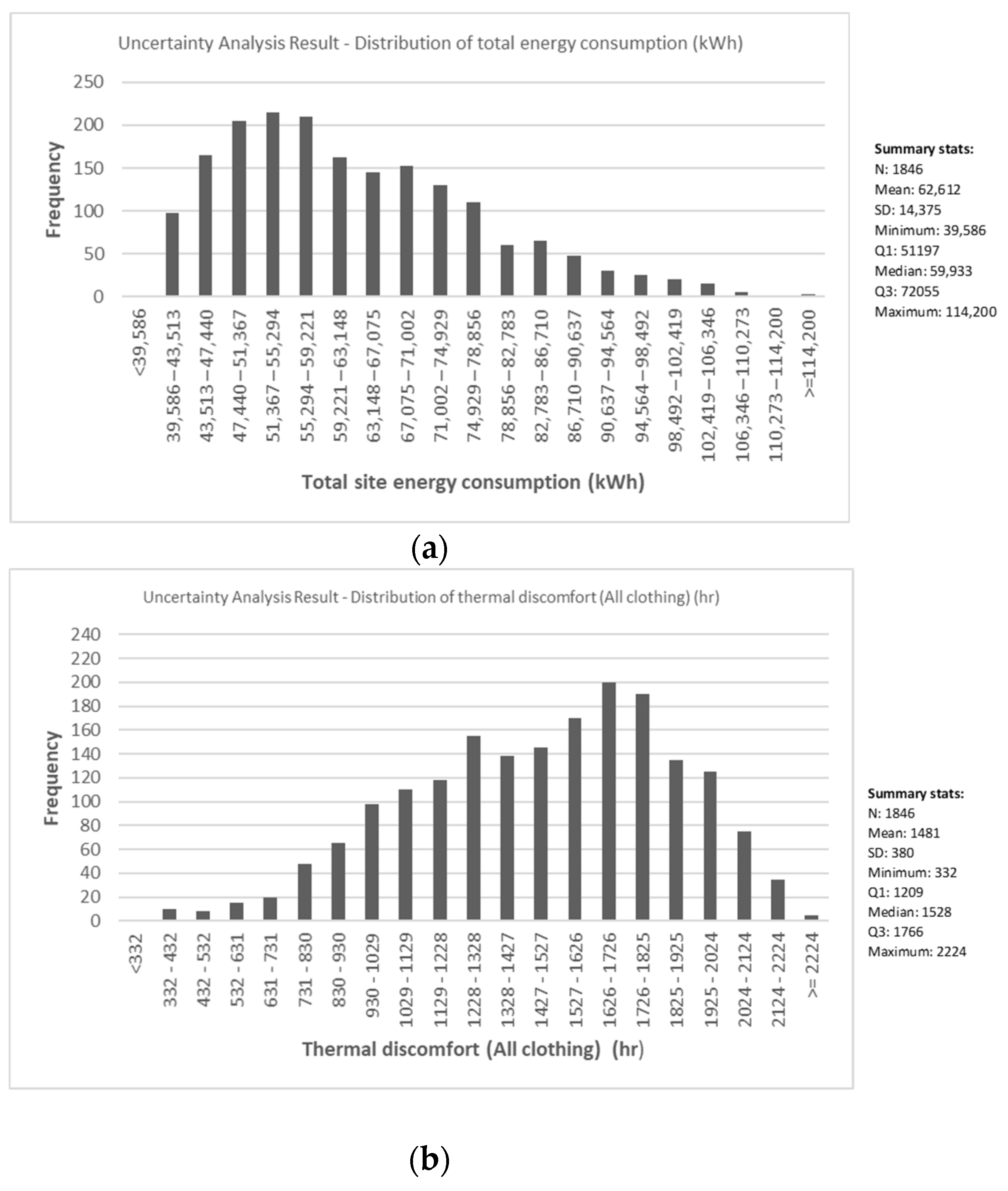

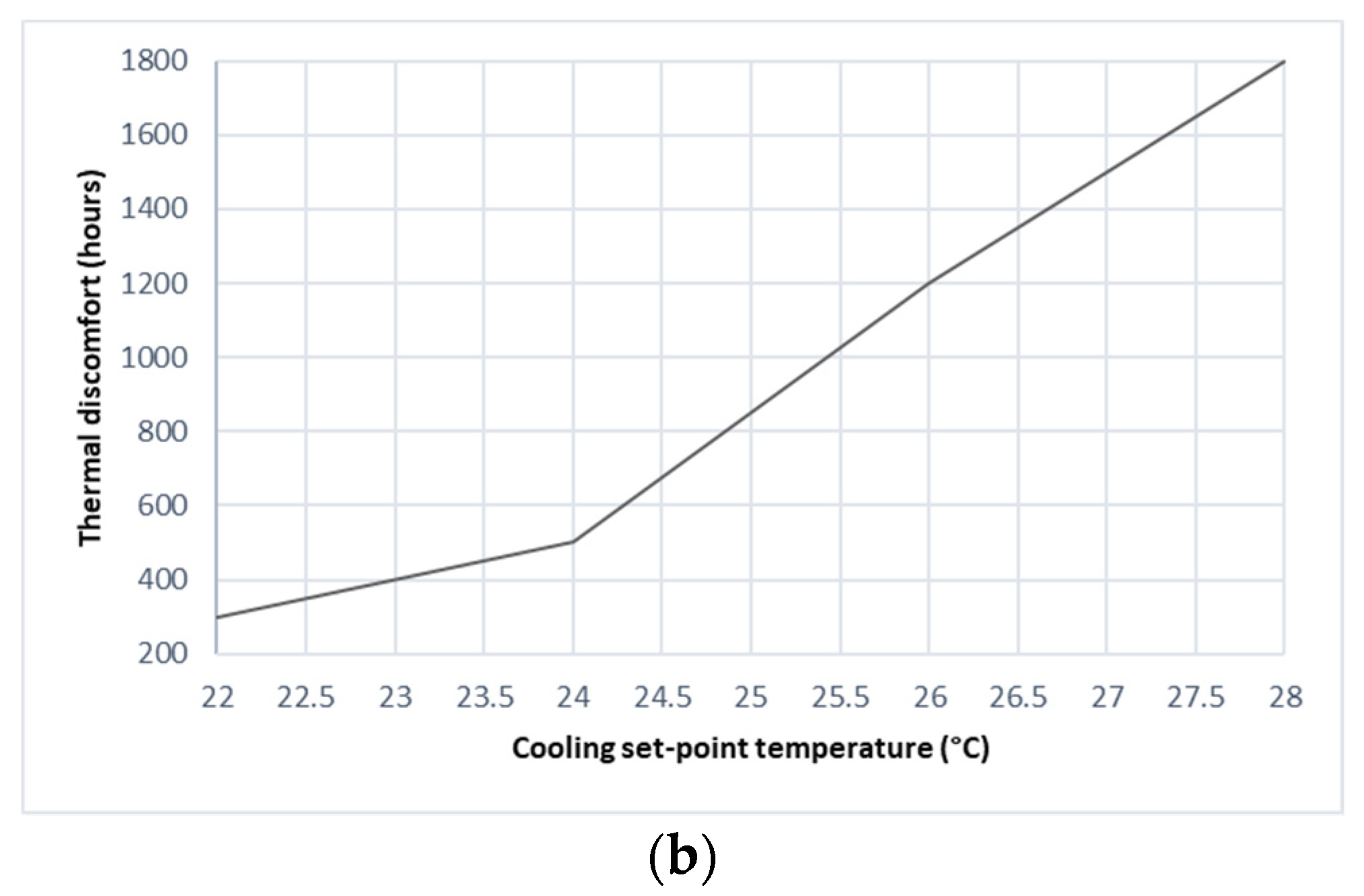
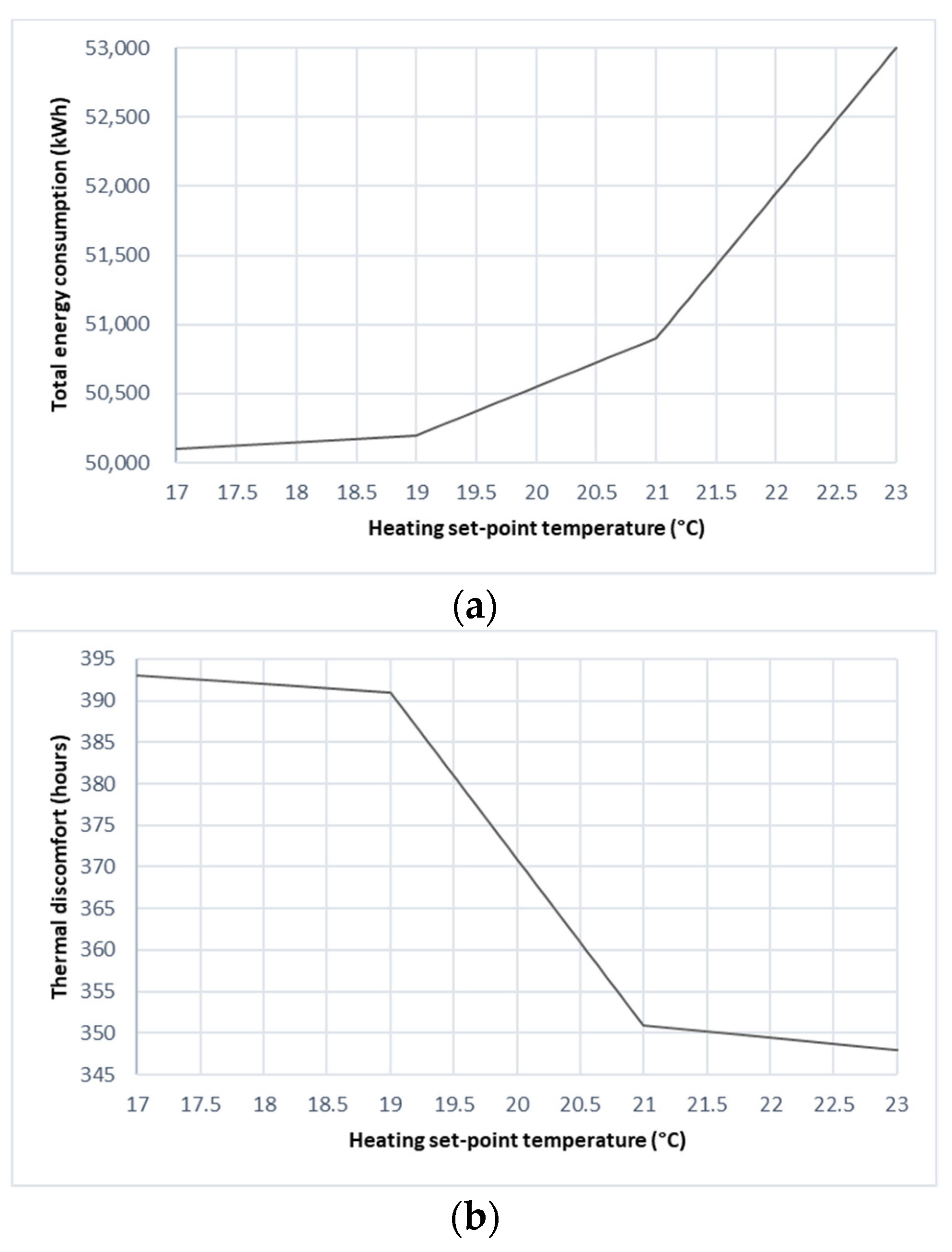
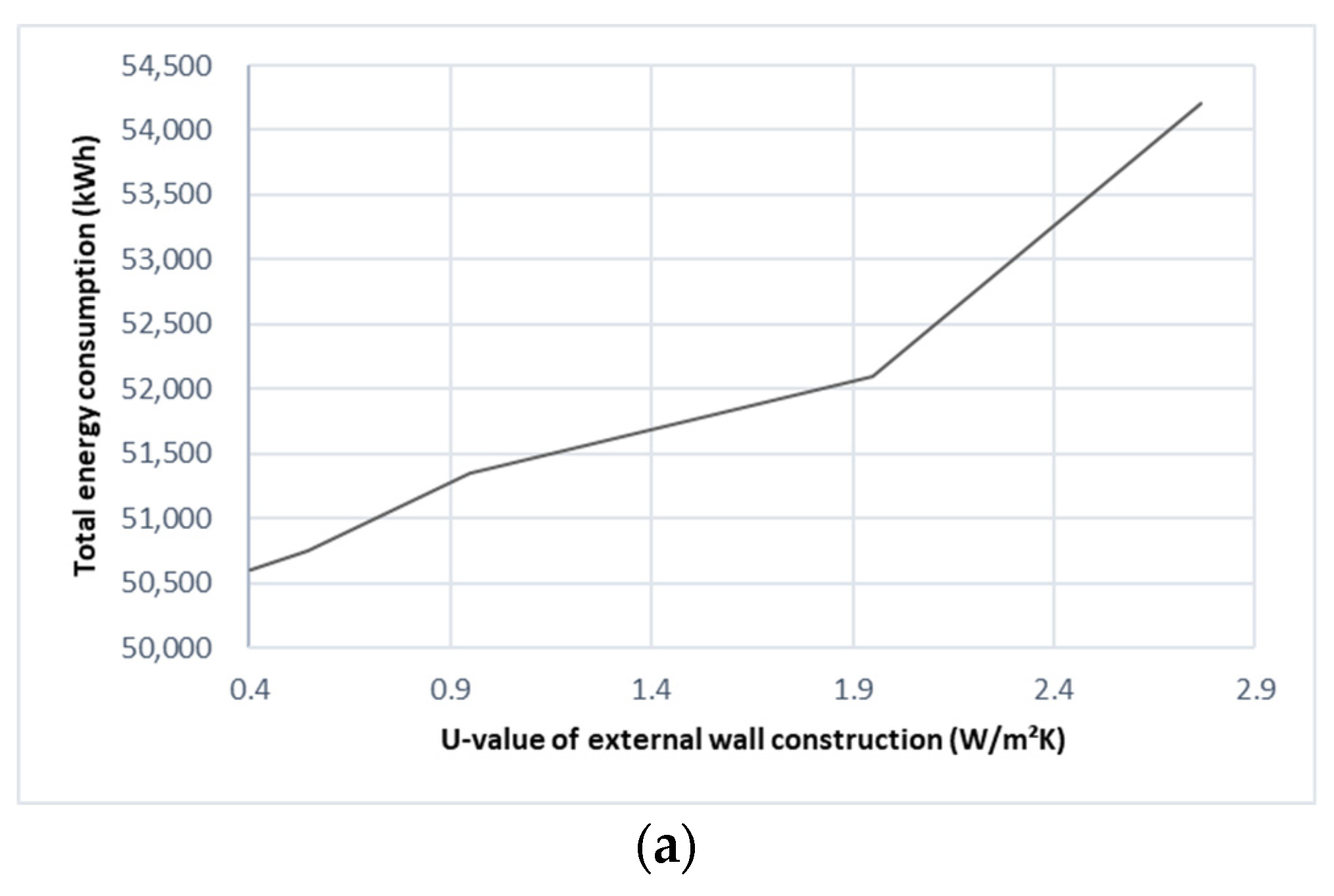


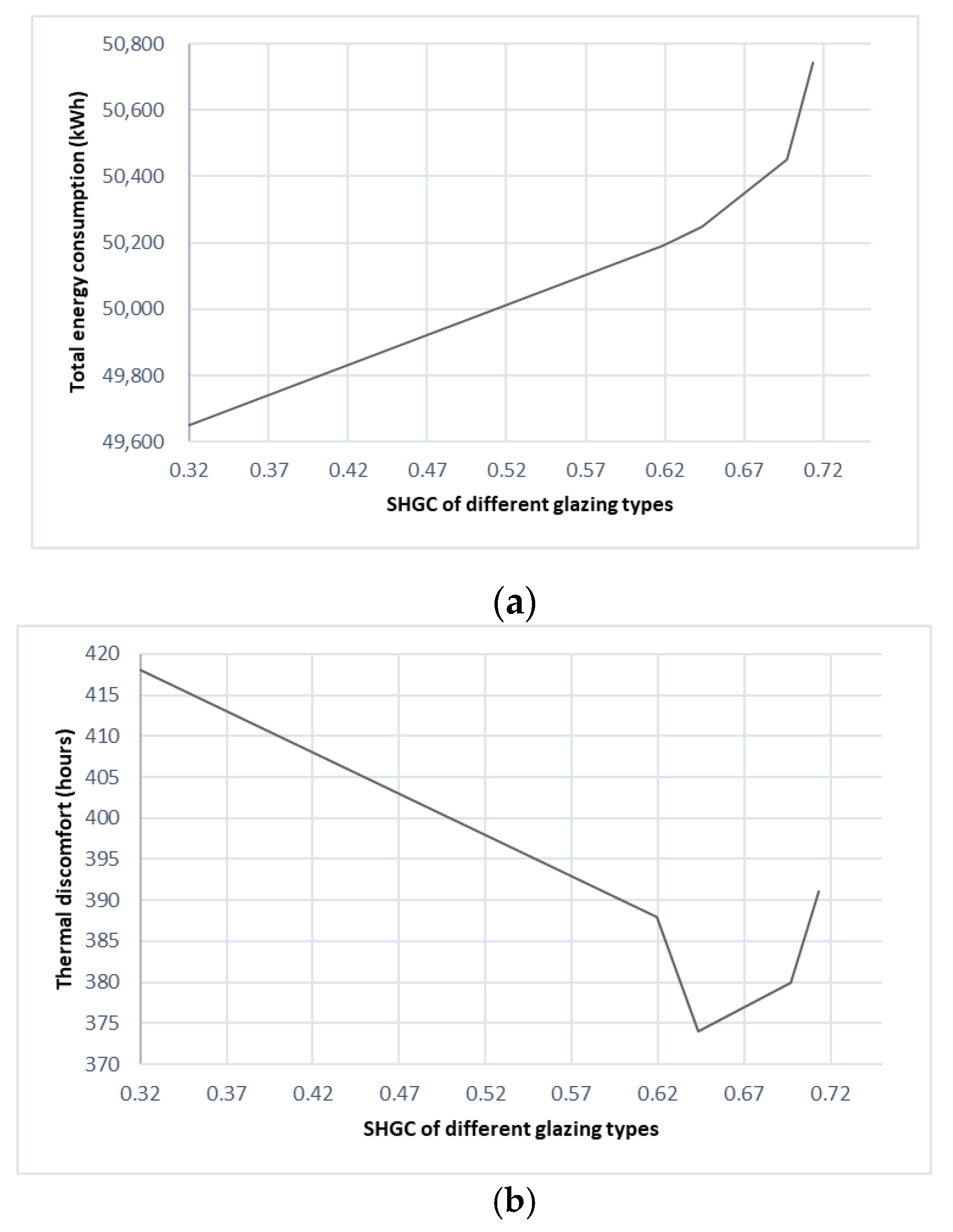



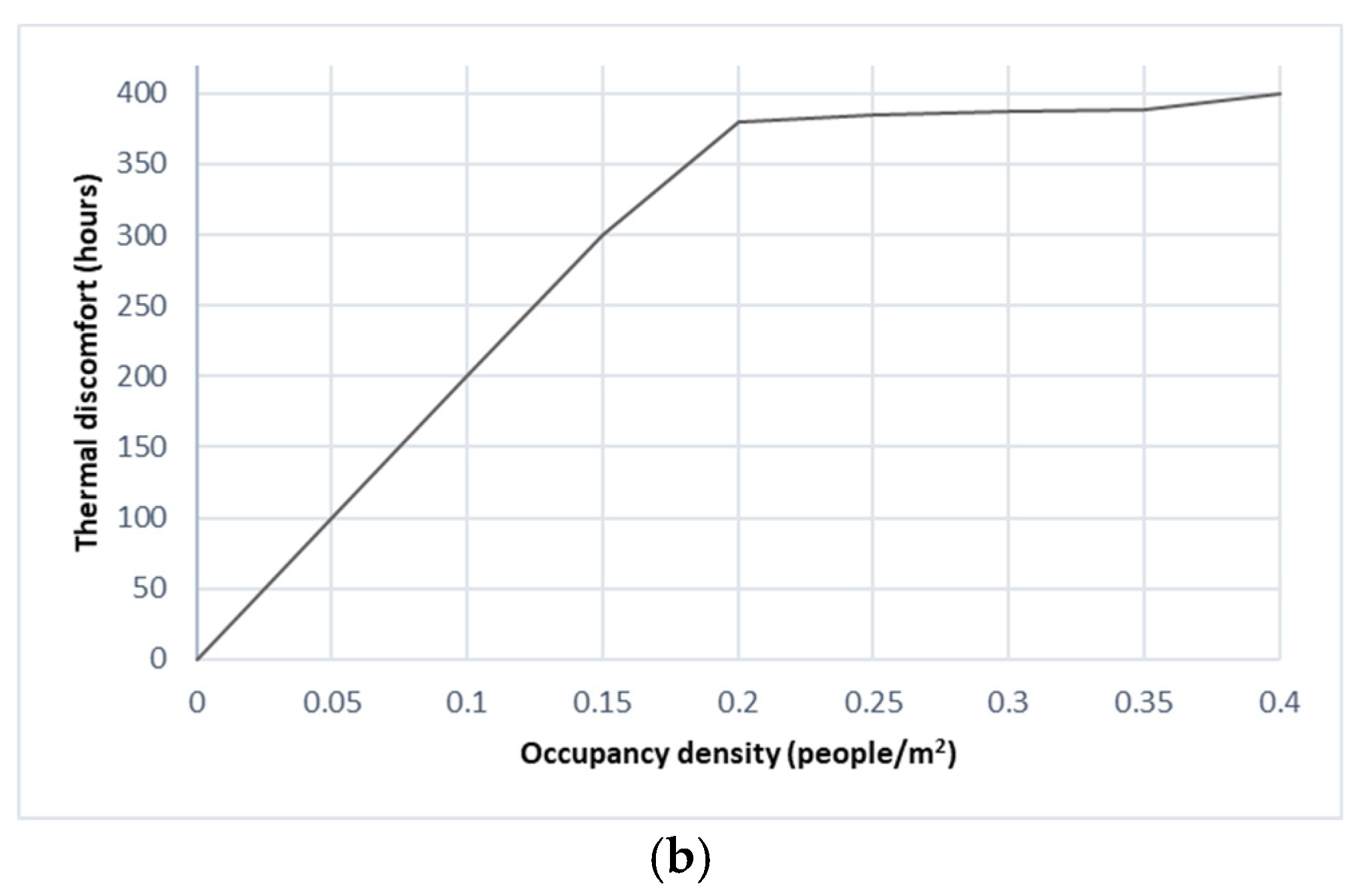
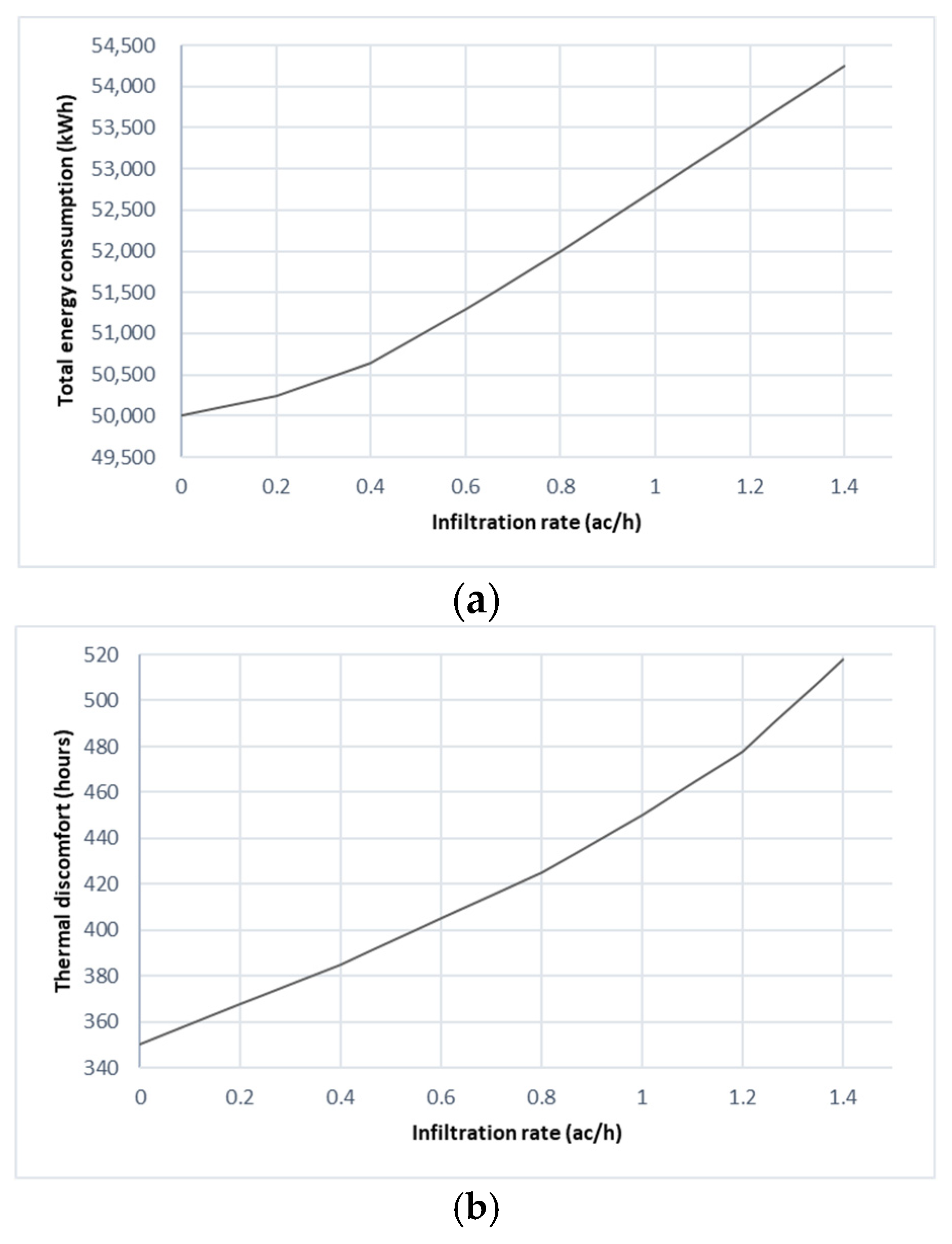
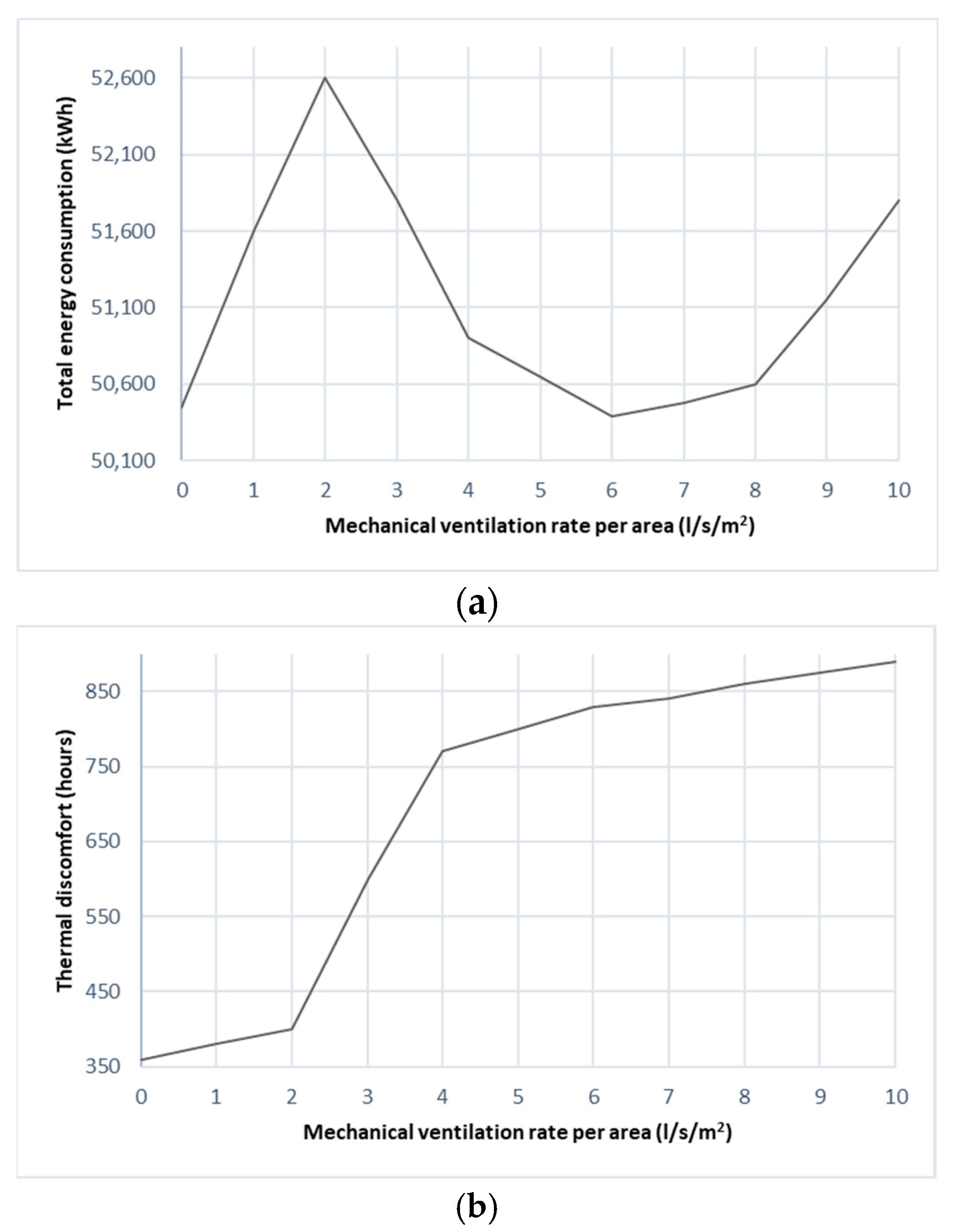
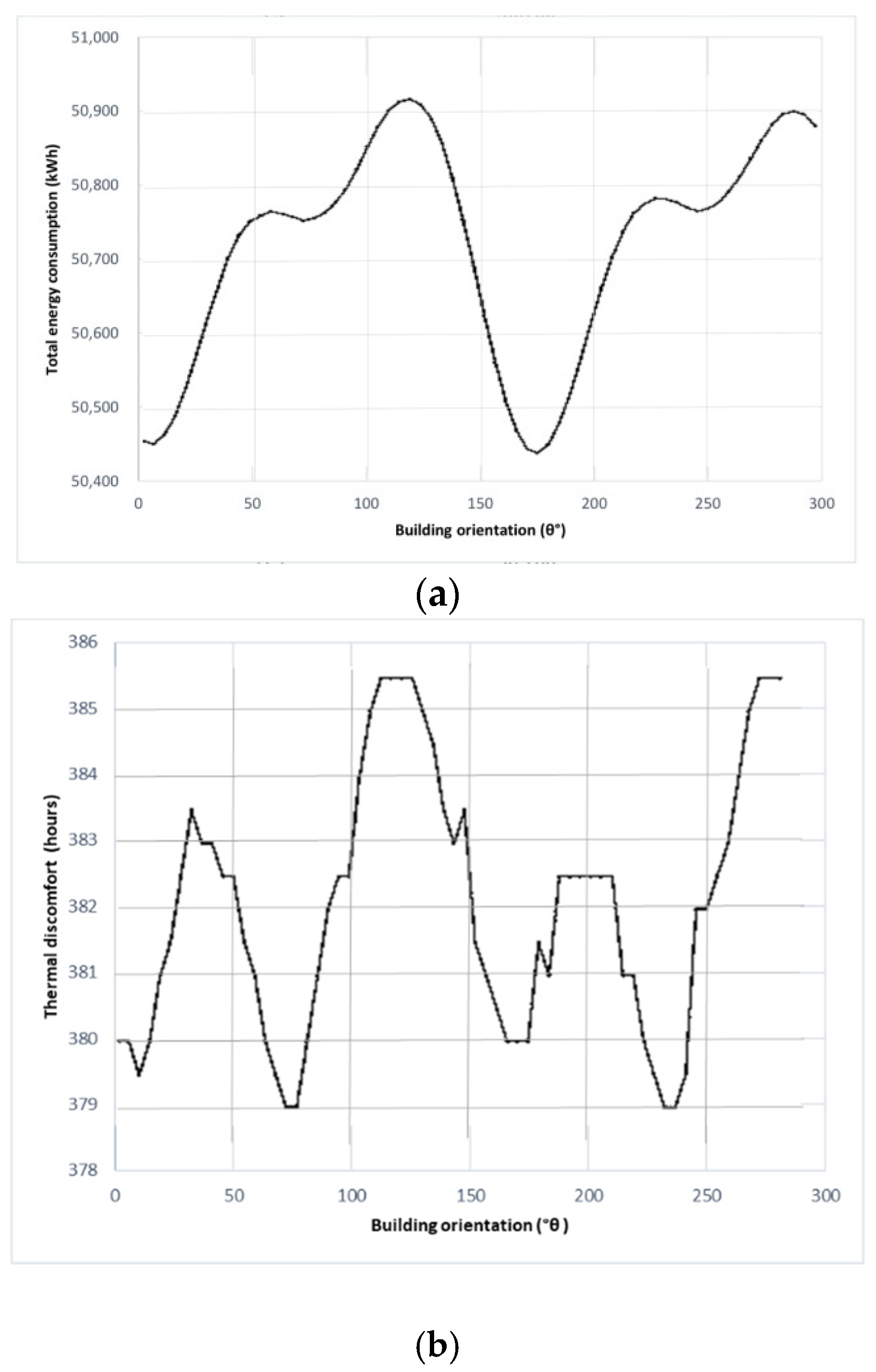
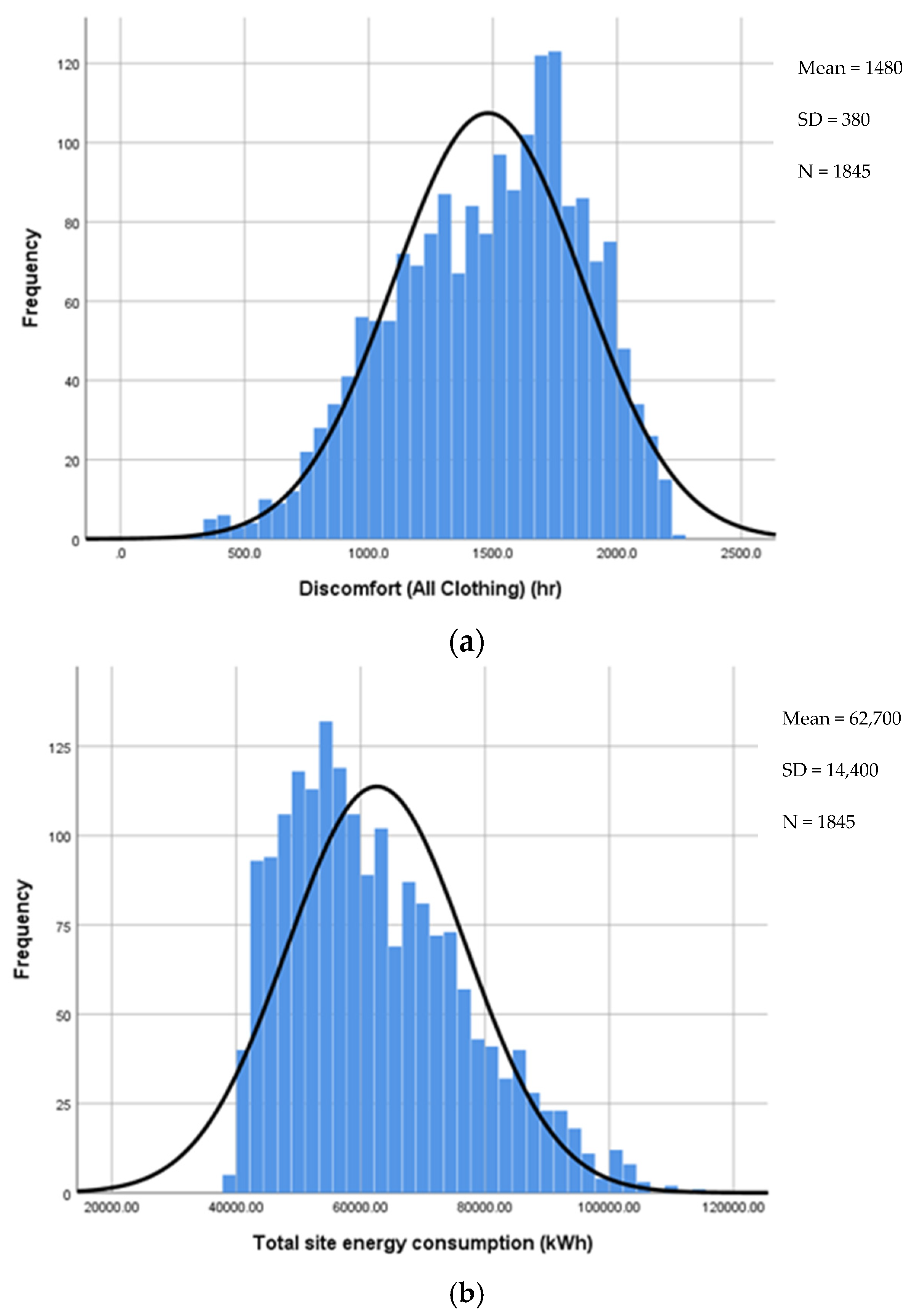
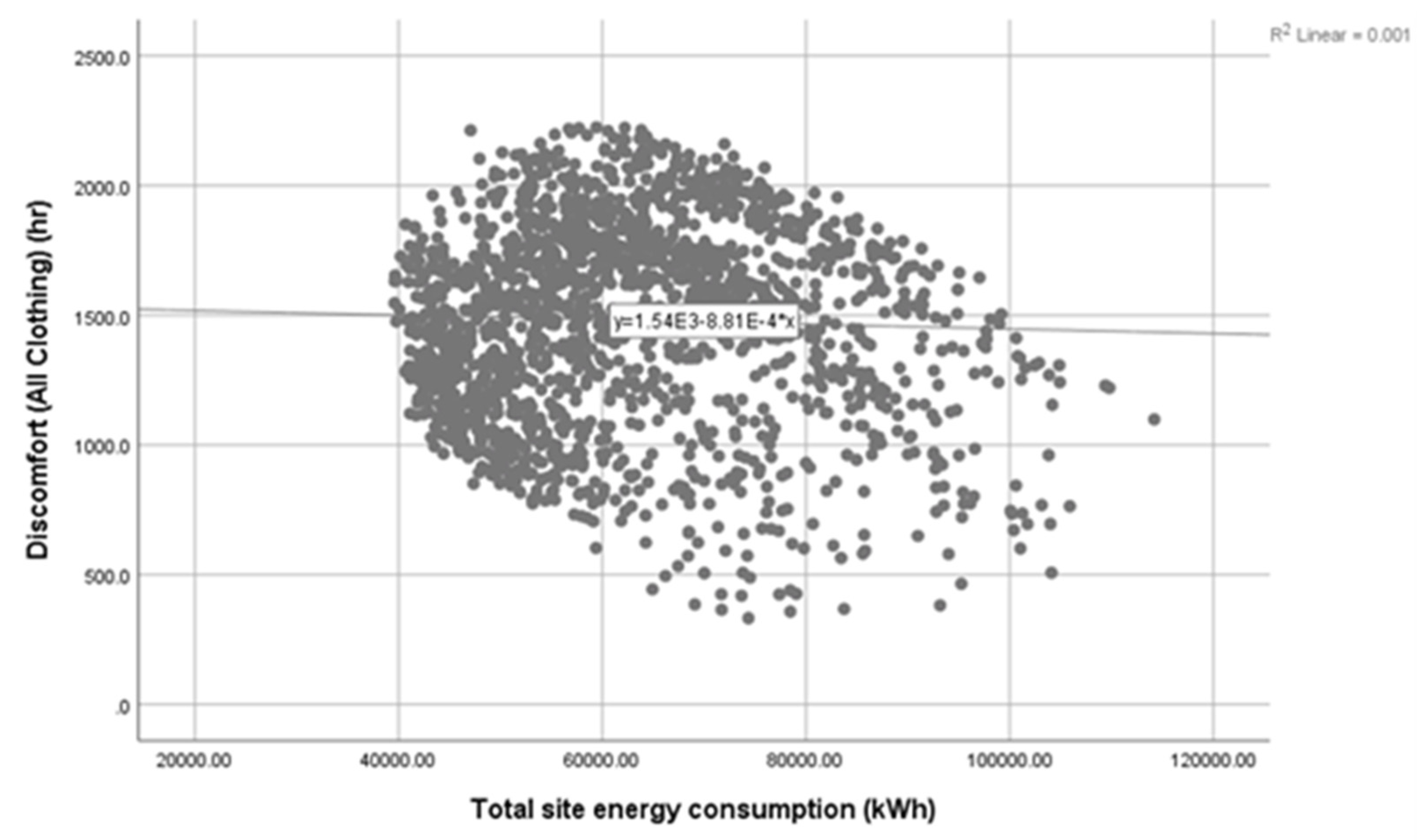

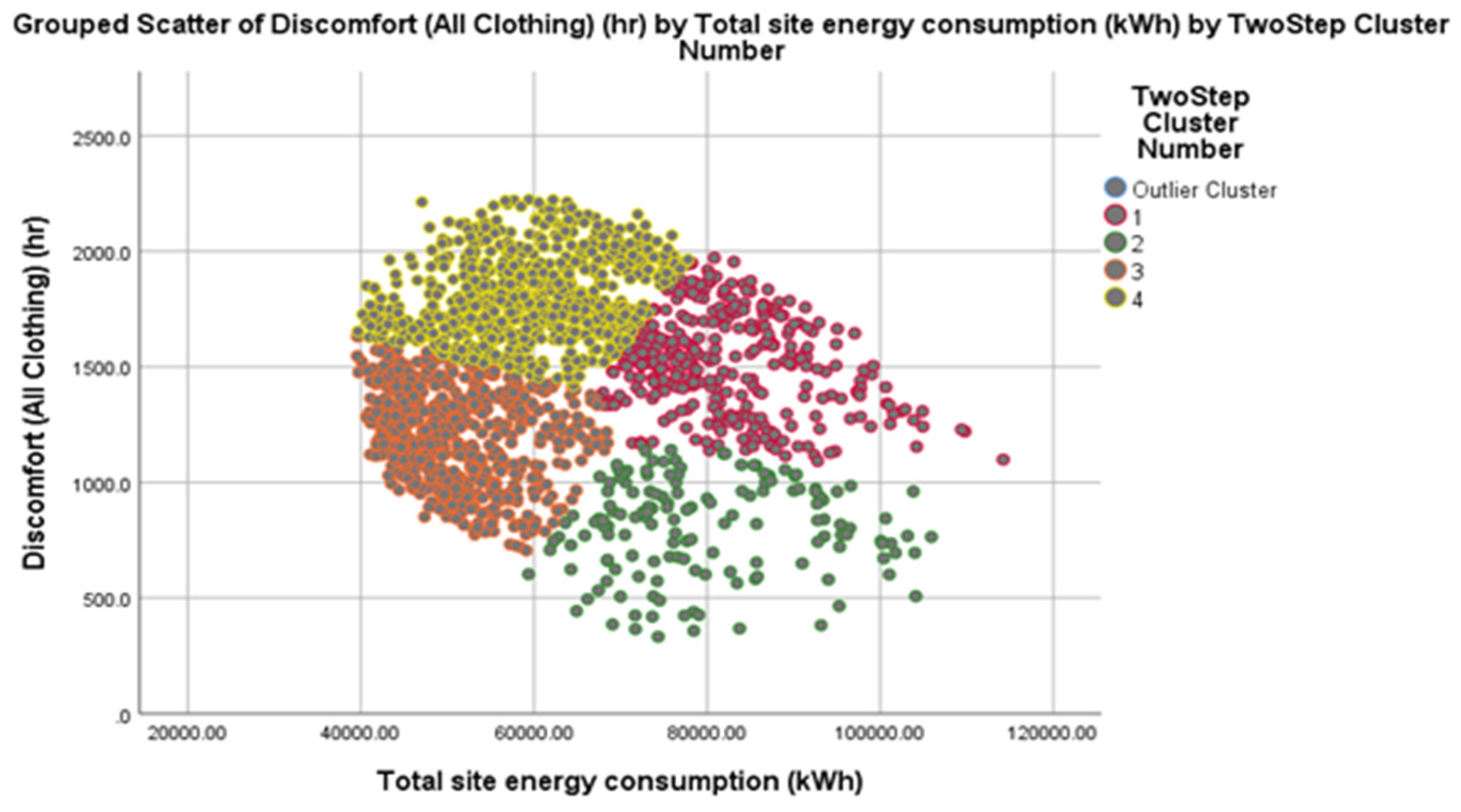
| The Extent of the Impact | ABDPs | Output 1 Thermal Discomfort Hours | ABDPs | Output 2 Energy Consumption | ||
|---|---|---|---|---|---|---|
| SRC | p-Value | SRC | p-Value | |||
 | Cooling set-point temperature (°C) | 0.5705 | 0.0000 * | Cooling set-point temperature (°C) | −0.6926 | 0.0000 * |
| Flat roof construction | −0.4317 | 0.0000 * | Flat roof construction | −0.4086 | 0.0000 * | |
| Heating set-point temperature (°C) | −0.3389 | 0.0000 * | Heating set-point temperature (°C) | 0.1852 | 0.0000 * | |
| Occupancy density (people/m2) | −0.0501 | 0.0006 * | External wall construction | 0.0553 | 0.0001 * | |
| Glazing type | −0.0409 | 0.0049 * | ||||
| Mech. vent rate per area (l/s/m2) | 0.0345 | 0.0178 * | Infiltration (ac/h) | 0.0525 | 0.0001 * | |
| Infiltration (ac/h) | 0.0319 | 0.0282 * | Window to wall ratio (%) | 0.0519 | 0.0001 * | |
| Occupancy density (people/m2) | 0.0472 | 0.0006 * | ||||
| Crack template (airtightness) | −0.0272 | 0.0612 | Crack template (airtightness) | −0.0214 | 0.1165 | |
| External wall construction | 0.0259 | 0.0749 | Roof window opens ratio (%) | −0.0214 | 0.1166 | |
| Building orientation (°) | 0.0176 | 0.2270 | Thermal mass | −0.0157 | 0.2478 | |
| Window to wall ratio (%) | −0.0162 | 0.2646 | Building rotation (°) | 0.0129 | 0.3436 | |
| Local shading type | −0.0087 | 0.5496 | Mech. vent rate per area (l/s-m2) | 0.0099 | 0.4695 | |
| Thermal mass | −0.0061 | 0.6743 | Location template | −0.0097 | 0.4744 | |
| Location template | −0.0028 | 0.8472 | Local shading type | −0.0085 | 0.5306 | |
| Roof window opens (%) | −0.0027 | 0.8531 | Glazing type | 0.0029 | 0.8302 | |
| Correlations | |||
|---|---|---|---|
| Discomfort (All Clothing) (h) | Total Site Energy Consumption (kWh) | ||
| Discomfort (All Clothing) (h) | Pearson Correlation | 1 | −0.033 |
| Sig. (2-tailed) | - | 0.153 | |
| N | 1845 | 1845 | |
| Total site energy consumption (kWh) | Pearson Correlation | −0.033 | 1 |
| Sig. (2-tailed) | 0.153 | - | |
| N | 1845 | 1845 | |
Publisher’s Note: MDPI stays neutral with regard to jurisdictional claims in published maps and institutional affiliations. |
© 2022 by the authors. Licensee MDPI, Basel, Switzerland. This article is an open access article distributed under the terms and conditions of the Creative Commons Attribution (CC BY) license (https://creativecommons.org/licenses/by/4.0/).
Share and Cite
Alghamdi, S.; Tang, W.; Kanjanabootra, S.; Alterman, D. Effect of Architectural Building Design Parameters on Thermal Comfort and Energy Consumption in Higher Education Buildings. Buildings 2022, 12, 329. https://doi.org/10.3390/buildings12030329
Alghamdi S, Tang W, Kanjanabootra S, Alterman D. Effect of Architectural Building Design Parameters on Thermal Comfort and Energy Consumption in Higher Education Buildings. Buildings. 2022; 12(3):329. https://doi.org/10.3390/buildings12030329
Chicago/Turabian StyleAlghamdi, Salah, Waiching Tang, Sittimont Kanjanabootra, and Dariusz Alterman. 2022. "Effect of Architectural Building Design Parameters on Thermal Comfort and Energy Consumption in Higher Education Buildings" Buildings 12, no. 3: 329. https://doi.org/10.3390/buildings12030329
APA StyleAlghamdi, S., Tang, W., Kanjanabootra, S., & Alterman, D. (2022). Effect of Architectural Building Design Parameters on Thermal Comfort and Energy Consumption in Higher Education Buildings. Buildings, 12(3), 329. https://doi.org/10.3390/buildings12030329









